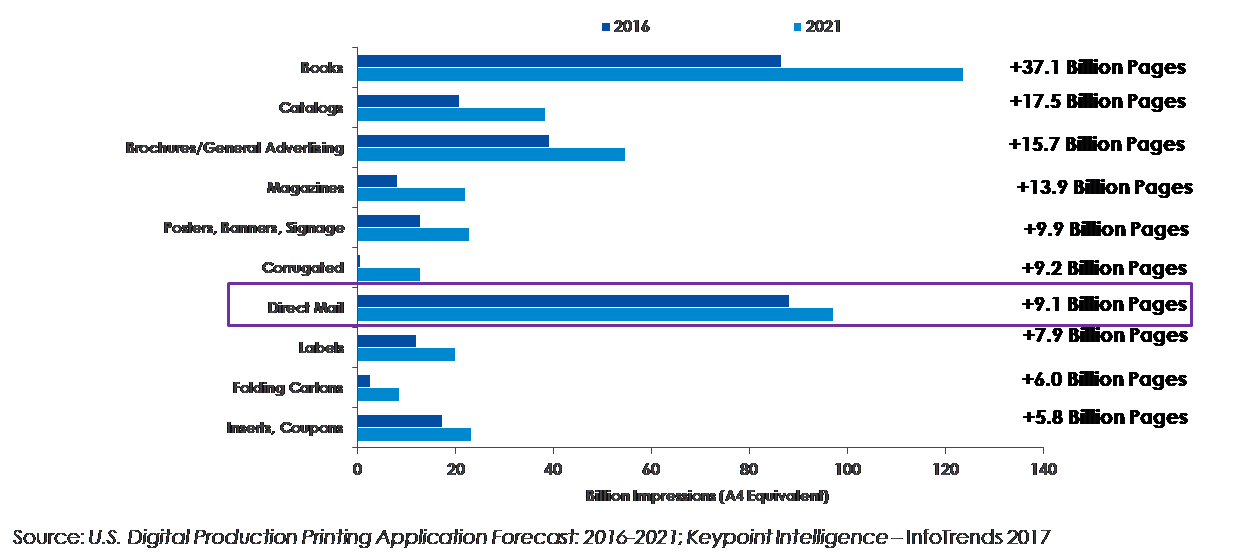This article originally appeared in the May/June, 2018 issue of Mailing Systems Technology.
In a world were printed direct mail is often in competition with digital media, high-speed inkjet printing devices are helping to level the playing field and creating new opportunities. Full-color direct mail with personalization — produced on high-speed inkjet devices — is proving successful in connecting and motivating consumers on emotional, practical, and subliminal levels.
According to a Keypoint Intelligence — InfoTrends’ survey of consumers, direct mail pieces that are relevant to recipients and include personalized content are more likely to get opened and read (Figure 1). Further supporting the effectiveness of personalization, in a different Keypoint Intelligence — InfoTrends’ study, 31% of marketers surveyed reported that the primary driver for personalizing print is they observed a direct correlation between personalization and response rates.

The use of personalized marketing is picking up pace as marketers are seeking better ways to capture attention, build brand awareness, and ultimately drive sales revenue. Delivering the right content to the right audience, in the preferred channel, at the right time, in the right context helps drive desired consumer actions (e.g., make a purchase, donate, or sign up).
The ability to personalize enhances results and is a factor driving growth of digitally printed direct mail. According to Keypoint Intelligence — InfoTrends’ annual digital page volume application forecast, direct mail volume is expected to grow by more than nine billion impressions from 2016 to 2021 (Figure 2).

The value high-speed inkjet production brings to direct mail is that it can do things that other print technologies can’t, including the ability to produce more affordable high-value personalization, short runs, and versioning. Inkjet technology can affordably deliver the customized direct mail communications that will engage an audience. While many direct mailers are turning to database marketing to improve results, there are limitations with traditional offset printing processes used to produce high-volume direct mail. While offset presses offer customers economies of scale in producing long-run print jobs, images are static and shorter runs are cost-prohibitive. The only way customer data could be leveraged with personalized offset printed direct mail is to laser-print messages on pre-printed work. This two-stop process is time-consuming and limited in its ability to leverage customer data.
High-speed digital inkjet printing enables direct mail campaigns to include unique text and graphics based on a recipient’s demographic characteristics or purchasing preferences. Higher levels of personalization typically lead to increased ROI of a direct mail campaign.
In addition, inkjet allows print providers to combine or gang together different jobs or different components in a campaign in the same print run, which leads to big efficiency gains. Direct mail programs can include many components such as a letter, a reply device, certificate, and other printed pieces. All of these pieces can be printed at the same time, and then they can be folded and cut separately.
The ability to gang jobs and run them by geographic region also has a major impact on postal savings. By commingling different mail pieces into larger-volume batches, customers can take advantage of bulk volume mailing discounts. This is important because postage is typically the highest expense in direct mail campaigns.
Key benefits high-speed inkjet offers direct mail production include:
· A single-step process (versus printing offset shells and then laser printing them)
· No printing plate changes
· Reduced labor
· No pre-printed shells/inventory
· Waste reduction
· Ganging together different jobs
· Printing a wide variety of applications (e.g., cards, letters, labels)
· The ability to produce in postal sequence at lower postal cost
· Moving to a completely digital workflow
High-speed inkjet printing is taking direct mail to a new level by enabling affordable production of pieces targeted to individual recipients. Targeted direct mail pieces drive response rates and business results. In addition to better campaign results, inkjet offers an opportunity to reduce postal costs. Overall, inkjet is creating new opportunities in direct mail.
Lisa Cross, Associate Director of InfoTrends’ Business Development Strategies Consulting Service, is responsible for conducting market research, managing consulting projects, and assisting companies in developing multi-channel communication, marketing, and content strategies.













